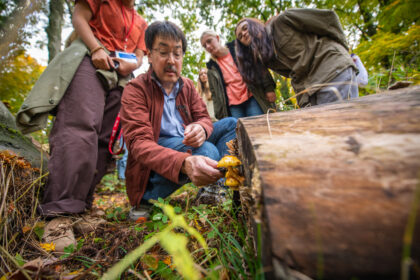From bon appétit to biofuels

A study by Clark University Biology Professor David Hibbett and 38 other researchers from across the world traces the evolution of the shiitake mushroom — which humans have cultivated and spread globally for centuries — that could inform the production of biofuels. The findings were published in the Proceedings of the National Academy of Sciences (PNAS).
The article, “A Global Phylogenomic Analysis of the Shiitake Genus Lentinula,” by Hibbett, the study’s principal investigator, reports the first in-depth genomic survey of a genus of Agaricomycetes, the fungi that include most of the world’s mushrooms. Since 1997, Hibbett has authored nine PNAS articles — and nearly 200 other publications, including in Science and Nature — that explore the evolution and ecology of these fungi.
In addition to its revered culinary qualities, shiitake possess other characteristics that, if better understood, could help improve the process of obtaining energy from plants. First emerging 28 million years ago, the shiitake mushroom belongs to the genus Lentinula, which are white rot fungi that break down organic substances such as cellulose, hemicellulose, and, most importantly, lignin, the cellular material forming the tough, fibrous parts of wood.
“Lignin,” Hibbett explains, “is the major barrier to producing bioethanol from coarse plant material.”

To better understand the evolution of Lentinula, the researchers completed sequencing of 24 new mushroom genomes from Asia — where shiitake, or Lentinula edodes, originated — Australasia, and the Americas, and assembled genomes from 60 existing sequences.
“When we went in and looked at all of these Lentinula genomes, what we found is that they’re pretty much all the same in terms of the repertoire of wood decay enzymes,” Hibbett told Genome Insider, a podcast produced by the U.S. Department of Energy Joint Genome Institute (JGI), which has supported the project through its Community Science Program.
The American shiitake, Lentinula raphanica, for example, has adapted to habitats from Alabama to Brazil, “suggesting that the same decay-related enzymes are useful in a wide range of environments,” according to the researchers.
The researchers also studied genes that encode enzymes involved in production of the unique aroma of shiitake mushrooms, identifying specific genes unique to Lentinula.
An American Association for the Advancement of Science Fellow, Hibbett began studying Lentinula as a doctoral student at Duke University in the late 1980s, continuing his work as a post-doctoral researcher at Japan’s Tottori Mycological Institute, the world’s leading center for shiitake research, in 1991-92. He returned to the United States for a second post-doctoral appointment at Harvard University before joining the faculty of Clark University in 1999.
Since childhood, he has eaten — and grown to appreciate — shiitake mushrooms. His mother’s side of the family comes from Japan, where shiitake got their name: shii for the oak tree where they often grow, and take, the Japanese word for mushroom.
Now the second most cultivated mushroom in the world, shiitake were first grown and harvested in China between 1000 and 1100 A.D. Species of Lentinula can be found everywhere except Europe, Africa, and the polar regions — “as far as we know, that is,” Hibbett
In addition to JGI’s Community Science Program, Hibbett’s Lentinula project received funding from the National Science Foundation.


